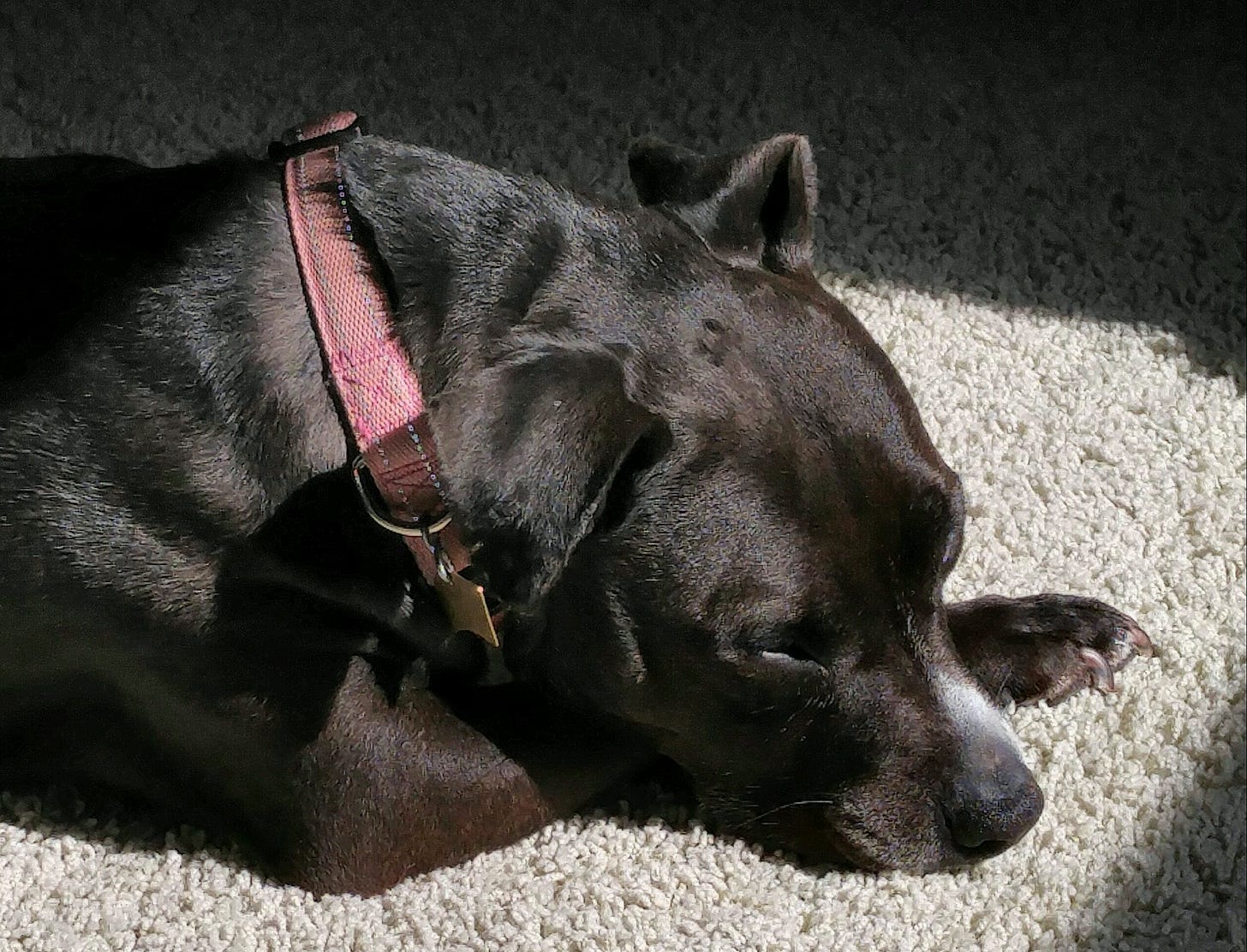Lean into life when you lose someone you love.
We are always dying. But we are also always living.

Love both life and death. Love your life, and love those who have died. Do both fully, and you will lean into what it means to be completely human and completely alive.
You can listen to the audio version of this essay below:
I wasn’t ready. Everyone else was.
Ben started looking at rescue dogs the day our pit bull mix Lily was scheduled to be euthanized: January 17, 2022. It felt cruel to me, a slap in the wake of death. I couldn’t imagine life without her. I still can’t, over two years later.
Ben kept asking me, “Are you open to looking for a new dog?” He said this when Lily was still snoring at my feet while I journaled in the morning. He said this when she followed me—limping, room to room.
My response was, “I’m not ready for another dog yet, but I’m open to looking when the right one comes along.”
I knew my husband well enough to know that he’d found “the right one” when he kept showing me the dog’s photo. He’d made up his mind.
We talked it over with the kids. They were elated. Joey exclaimed, “I wanna new dog!” But, really, he was three at the time and clueless about life and death. So far.
So I acquiesced. I usually do. The pet rescue had named the dog Brenna, but Felicity renamed her to Daisy. And she responded to that, so it stuck. I thought about how Lily was just in our house six days before Daisy arrived. Lily. Daisy. Flower themes, I guess.
It’s flowers that remind me of life and death, of rebirth.
Daisy quickly became Ben’s dog, and he, her person. Mine is gone. I tried to tell myself, maybe Ben was the one who would need comfort these next several years. Maybe I am the strong one now.

Felicity approached me a couple of weeks after Lily died and said forlornly, “I don’t smell Lily anymore.”
I paused to think, then said, “You’re right.” We evacuated Lily’s special couch. I washed all of her blankets and Cloroxed her dog crate. Her water and food bowl went directly into the dishwasher, and I stowed away her old toys, sweaters, and Halloween costumes—the ones that were salvageable, anyway.
Neither Felicity nor I spoke for a beat. We shared a sad moment, one without words. One in which words were inadequate, hollow.
When we grieve, I realized, we are desperate for any connection with the dead. This is true especially as days become weeks become years. Memories fade. We edit them to reflect what we want to recall. And what we long for are: a sign of their presence, the smell saturated in a garment, the sound of their voice.
Maybe we should relegate the deceased to a photograph, as Joan Didion wrote in The Year of Magical Thinking. Let the dead be dead, she said.
Maybe. But maybe not. Maybe we need to hold onto something tangible that keeps the ones we love alive somehow. Because we are drawn to what lives and what lives on. We know that death is not the way things should end.
And I think that’s why we can keep the ones we love alive. Because they do live somewhere. They live in the lilies and daisies—just like the namesakes of my rescue dogs, both past and present. They live in the handwritten notes and cards we saved (or, in this case, the tree ornament with Lily’s paw print impressed on it). They live in our fragmented memories that we piece together with old photos and conversations with those who loved them, too.

The ones we love live on, because we keep them alive through us, by the way we choose to honor them and live out the best of their temperament—their integrity, their compassion or generosity or mirth. They live on, because everything that lives must somehow contribute to the next living thing, and the next.
We don’t want to confront death, do we? But there are so many reminders every day that we must face it at some point. Even as we live, we are one day closer to death.
We are always dying. But we are also always living.
The circulation of both dying and living creates a place of tension, in which we feel the sadness of what we are losing and have lost, but also the delight in what we are becoming.
It is the becoming that connects the living to the dead, the becoming that rejuvenates what it means for us to hope and to carry on, the becoming that awakens us to love. And it is love that never dies, if we both hold and surrender it. It is love that points most fully to rebirth and regeneration.
So, love both life and death. Love your life, and love those who have died. Do both fully, and you will lean into what it means to be completely human and completely alive.





The dead live in the world around us, that love continues, lean into the rebirth of a new you in how they reshaped the old you. They live in our fragmented memories and in the way we honor them by living with their best characteristics in mind. Their love continues in us and through us as we live on. As we live on a part of them lives on. That brings me a sense of peace.
I'm sorry for your loss, Jeannie. I remember how struck I was at the magnitude of losing my furry girl a couple of years ago. And I could not reconcile how my grief was not appropriate, was considered excessive, but family is family. And loss is loss. It is part of life's journey yet remains unbelievably hard.